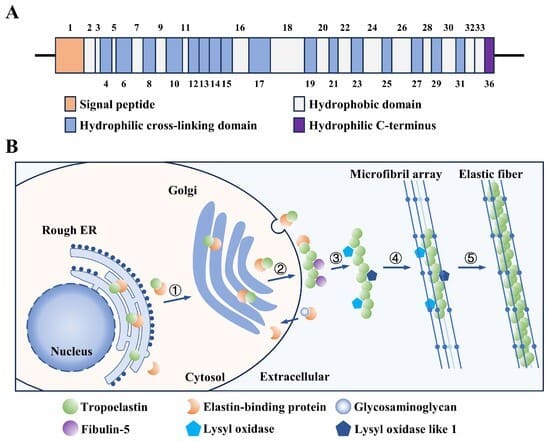Our customer service representatives are available 24 hours a day, from Monday to Sunday.
| Catalog Number | CI-SC-1134 |
| Product Name | Elastin |
| CAS | 9007-58-3 |
| Synonyms | Elastins |
| IUPAC Name | (2S)-1-[(2S)-2-[[2-[[(2S,3S)-2-[[(2S)-2-acetamido-4-methylpentanoyl]amino]-3-methylpentanoyl]amino]acetyl]amino]-3-methylbutanoyl]-N-methylpyrrolidine-2-carboxamide |
| Molecular Weight | 552.7 g/mol |
| Molecular Formula | C27H48N6O6 |
| InChI | InChI=1S/C27H48N6O6/c1-9-17(6)23(32-24(36)19(13-15(2)3)30-18(7)34)26(38)29-14-21(35)31-22(16(4)5)27(39)33-12-10-11-20(33)25(37)28-8/h15-17,19-20,22-23H,9-14H2,1-8H3,(H,28,37)(H,29,38)(H,30,34)(H,31,35)(H,32,36)/t17-,19-,20-,22-,23-/m0/s1 |
| InChI Key | DPUYCSDGMSDKKV-MKBYFEBXSA-N |
| Purity | 90% |
| Appearance | Solid |
| Highest Usage In Residency Products | 0.3 |
| Isomeric SMILES | CC[C@H](C)[C@@H](C(=O)NCC(=O)N[C@@H](C(C)C)C(=O)N1CCC[C@H]1C(=O)NC)NC(=O)[C@H](CC(C)C)NC(=O)C |
 Lei, Ting, et al. Cosmetics, 2025, 12(1), 18.
Lei, Ting, et al. Cosmetics, 2025, 12(1), 18.
Protein has been recognized as an important ingredient in anti-aging cosmetics. Its main functions are to maintain the moisture balance of the stratum corneum, inhibit wrinkle formation, and promote the synthesis of ECM proteins. Elastin serves as an essential protein within the skin and resides chiefly in the extracellular matrix (ECM). In the dermis elastic fibers comprise elastin which maintains both skin elasticity and its structural integrity.
Traditional cosmetics contain elastin extracted from animal tissues such as aorta ligaments tendons and skin through chemical or enzymatic processes. Below presents research cases where elastin functions as an active ingredient in cosmetic products.
· Hot alkali method-derived water-soluble porcine aortic elastin displays wide molecular weight distribution while offering significant moisturizing and whitening effects.
· The antioxidant activity of elastin peptides extracted from bovine neck ligament through enzymatic hydrolysis is significant.
· The proteolytic breakdown of bovine ligaments creates a product that stimulates cultured dermal fibroblast proliferation while significantly boosting their elastin production.
· Poultry provides valuable elastin in addition to mammalian sources. Elastin powder derived from poultry skin shows potential as an anti-wrinkle ingredient that helps improve skin firmness. The physical and chemical properties of creams containing poultry skin elastin remained stable throughout 12 weeks with consistent pH levels and viscosity and color.
 Guerle-Cavero, Rocío, et al. International journal of molecular sciences, 2023, 24(13), 11016.
Guerle-Cavero, Rocío, et al. International journal of molecular sciences, 2023, 24(13), 11016.
This study explored the anti-aging properties of elastin (EL), hydrolyzed collagen (HC), and two vegetarian collagen-like products (Veg Col) within tri-layered chitosan films ionically cross-linked with sodium tripolyphosphate (TPP).
Preparation of Tri-layered Films
In the initial phase, either EL, HC, or Veg Col was incorporated into the two inner layers (2L(i+b)), and their effects were assessed against those in three-layered films (3L).
Key Findings on Elastin-Tri-layered Films
· The results indicated that the active ingredients-EL, HC, and the two Veg Col products-contribute to pore reduction, decreased water penetration, increased elasticity, and enhanced hydration and moisturizing, thereby confirming their anti-aging effects.
· For permeability assessments related to pore reduction, measurements showed a correlation between reduced pore size from certain EL and HC concentrations and lowered permeability. Notably, while pore reduction was similar for both ingredients, EL exhibited a more substantial reduction in permeability due to its hydrophobic segments.
· Regarding elasticity, an inverse relationship was noted between concentration and elasticity for both EL and HC. EL at a concentration of 0.085% in 2L(i+b) produced the most significant improvement in elasticity, achieving a 71% increase.
· In swelling assessments, EL at high concentrations displayed enhanced swelling in 3L compared to 2L(i+b).
· In moisture retention tests, both studied concentrations of EL demonstrated considerable moisture retention, with the highest retention-21%-observed at the higher concentration (0.27%) after 15 minutes (short term).
What is elastin and what role does it play in the body?
Elastin is an extracellular matrix protein crucial for providing elasticity and resilience to various tissues, including arteries, lungs, tendons, skin, and ligaments. It allows tissues to stretch and return to their original shape, facilitating dynamic facial expressions and movement.
How is elastin different from collagen?
While both elastin and collagen are structural proteins that help maintain skin texture and shape, elastin is significantly more flexible-up to 1000 times more than collagen. Elastin enables tissues to stretch and snap back, contributing primarily to elasticity, whereas collagen provides rigidity and support.
Where in the body is elastin most prevalent?
Elastin is predominantly found in the dermis layer of the skin, lungs, blood vessels, tendons, ligaments, and the bladder wall. While it is present in varying amounts, tissues like the skin contain higher levels of elastin to maintain suppleness.
How does elastin contribute to skin health?
Elastin plays a significant role in maintaining skin elasticity, which is critical for a young and healthy appearance. Strong elastin fibers help reduce wrinkles and sagging, promote wound and scar healing, smooth out skin tone and texture, and uphold the skin's structural integrity.
What happens to elastin as we age?
As we age, the production and quality of elastin in the skin can decline, leading to reduced elasticity and the formation of wrinkles and sagging. Maintaining healthy elastin levels is crucial for keeping the skin looking youthful and elastic.
Can the condition of elastin in the skin be improved?
Although the natural decrease in elastin with age cannot be completely halted, maintaining a healthy skin care regimen and lifestyle can support elastin function. Using products that protect and nourish the skin, along with a balanced diet and adequate hydration, may help prolong its elasticity and overall health.
What can damage elastin in the skin?
Factors such as UV exposure, pollution, smoking, and inflammation can damage elastin in the skin, leading to its breakdown and potentially causing skin damage or diseases. Protecting the skin from environmental stressors is key to maintaining healthy elastin levels.